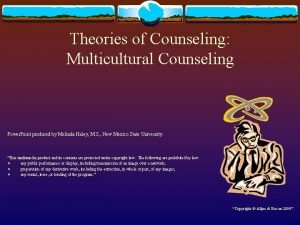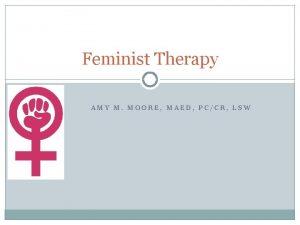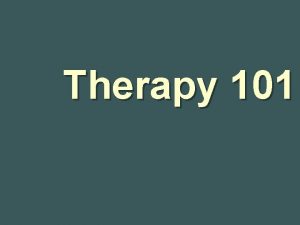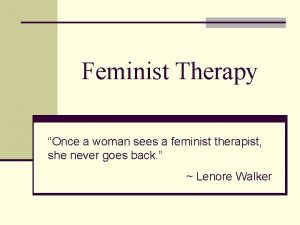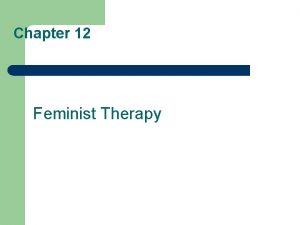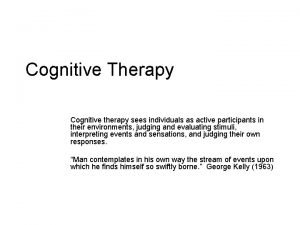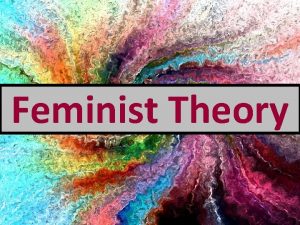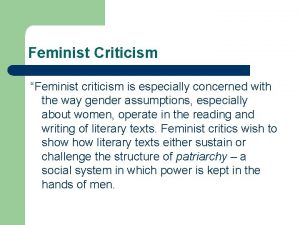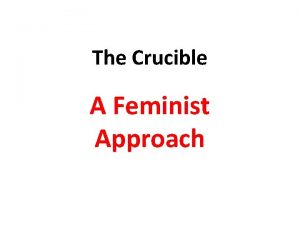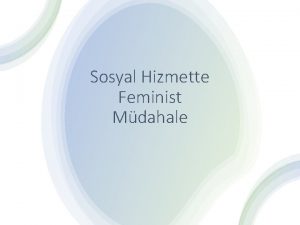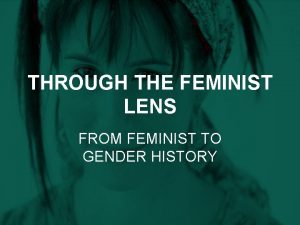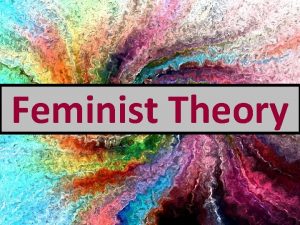Feminist Therapy Once a woman sees a feminist



























- Slides: 27

Feminist Therapy “Once a woman sees a feminist therapist, she never goes back. ” ~ Lenore Walker

Agenda n What is feminism? n A very brief history n Assumptions about human nature n View of personality development n View of psychopathology n Nature & techniques of therapy n What about men? n Does feminist therapy work?

What is Feminism? Feminism is a diverse, competing, and often opposing collection of social theories, political movements, and moral philosophies, largely motivated by or concerning the experiences of women, especially in terms of their social, political, and economic inequalities.

“Is feminism dead? ” (7 -15 -98)

Types of Feminism n A diverse, competing, and often opposing collection of social theories, political movements, and moral philosophies n Three main differences n Emphasize unique qualities of women? n Integrate issues of culture and class into viewpoint? n Advocate for rejection of masculine or patriarchal models?

Types of Feminism n Liberal Feminism n Emphasis on equality of women & men n Aims to change current legal structures and interventions to promote access for women n Criticized (by other feminists) for trying to be like men

Types of Feminism n Cultural Feminism n n n Emphasizes differences between men & women Values unique female qualities Gender interacts with race, social class, and other factors “We found that one important source of healing emerged when we got in touch with all the factors in our lives that were causing particular pain. For black females, and males too, that means learning about the myriad ways racism, sexism, class exploitation, homophobia, and various other structures of domination operate in our daily lives to undermine our capacity to be self-determining. ” -- bell hooks

Types of Feminism n Radical & Socialist Feminism n n n Left Oppression based on gender is the most stubborn form of injustice (Hillary Clinton heckled) Capitalism is oppressive The whole patriarchal, capitalist system needs to be abolished Advocates separatism Questions heterosexuality Radical/Social Cultural Liberal Right

History (herstory) n Karen Horney (1966) • Psychoanalyst who rejected “penis envy” • Women envy men’s power and social status n Phyllis Chesler (1972) • Criticized patriarchal male therapist-female client relationship (therapist is expert, woman submits to his wisdom) • Said that refusal to conform was labeled as mental illness n NOW (National Organization for Women) • Betty Friedan, 1966 • Political issues/discrimination laws and hiring processes n Consciousness raising groups (1970 s) • Bring about social change • No leaders, open discussion • Personal is political (gender role stereotypes in workplace, society)

Different meanings in different cultures

History cont. n Lenore Walker (Contemporary feminist therapist) Four stages of feminist therapy development 1. 2. 3. 4. Challenged traditional therapies Integrated some positive aspects of traditional therapy Advocated for all otherapies adding gender sensitive components Feminist therapy can stand on its own

Therapy from a Feminist Perspective n Developed out of dissatisfaction with traditional approaches to psychotherapy n The practice of therapy informed by feminist political philosophy and analysis, grounded in the multicultural feminist scholarship on the psychology of women and gender. n Feminist therapy contends that women are in a disadvantaged position in the world due to sex, gender, sexuality, race, ethnicity, religion, age and other categories

Therapy from a Feminist Perspective “A therapy which fails to address power issues in people’s lives works automatically to reinforce oppression” -- Mc. Lellan, 1999 “We found that one important source of healing emerged when we got in touch with all the factors in our lives that were causing particular pain. For black females, and males too, that means learning about the myriad ways racism, sexism, class exploitation, homophobia, and various other structures of domination operate in our daily lives to undermine our capacity to be self-determining. ” -- bell hooks on “interlocking oppressions”

Assumptions about Human Nature n We exist in a political and social system that is male dominated: Patriarchy n In order for women to experience changes in personal lives, political changes (to social institutions) must occur n Gender schemas/sex-role stereotypes limit development • In society, men have more power than women • Women are taught to rely on men

Patriarchy n Masculine behaviors and thought patterns are the norm n Hierarchy of value and power based on gender, race, class, sexual orientation, etc. n Men and women are judged differently for the same characteristics Sex n Biological: Male/Female n Usually dichotomous Gender n Social construct: Masculine/Feminine n Occurs on a continuum

Gender Socialization n Gender and Children n First question asked? n Males preferred in some cultures n Infant behavior across gender is similar: treatment is different n n n Baby’s clothing predicted how “it” was treated (Smith & Lloyd, 1978) Media, teachers, peers, etc. often provide and reinforce gender role expectations (i. e. , what is socially appropriate for females & males) Over time, a gender role schema develops: We interpret our world based on our gender expectations

Gender socialization cont. n Puberty n Sex differences become more visually apparent n Conflict for girls because of how society views the female body and role of female sexuality-conflicting n n n Importance of appearance (especially for girls) Sexual double-standard Negative response to menstruation n Adulthood n n n Working mom/Superwoman Role strain/conflict Lack of support (at work and home) Glass ceiling “Empty Nest” Menopause

Views on Psychopathology n Psychological distress is environmentally induced via gender roles and (sexist) social forces n n Women at higher risk for role strain and conflict Women more likely to experience sexual trauma/harassment n Psychological distress is a logical response to a stressful environment n Women are over-represented in certain psychological disorders due to socialization and social influences (not because of biological differences) n n Eating disorders Depression Anxiety PTSD

Views on classification n Classification systems considered problematic n DSM criticized for being male-centered (male = norm) n Dependant and histrionic personality disorders are in the DSM n Dominating, greedy, macho personality disorders? n Classification focuses on symptoms, underemphasizes social context (PTSD an exception) n Diagnostic labeling criticized for encouraging adjustment to male-centered social norms

Views on specific psychological problems n Depression n Women taught to be helpless, dependant, please men Feel unable to control their lives or assert true self Appearance = worth n Generalized Anxiety = conflicting social expectations n PTSD = fear, anxiety, stress felt after victimization (e. g. , rape, abuse) n Eating disorders n n Socialization and societal messages Use gender role analysis to examine external messages

Goals of Feminist Therapy n Consciousness raising; subordinate group that has been wronged n Recognize self in social context n Choose own path n Develop sense of self based on own needs n Restructure schema, insight n Empowerment n Political awareness n Self-esteem, remove lens of others

What a feminist therapists does… n Is aware of what he/she brings to the table (own values) n Forms egalitarian relationship Demystifies therapy n Respects what client brings to therapy n Is aware of power balance; gives client permission to be understood n Self-discloses own struggles (if/when therapeutically appropriate) Considers social, political, historical, & cultural contexts…then psychological things Supports (interpersonally, women’s groups) Educates n Power analysis n Gender role analysis n Bibliotherapy Is technically eclectic, but… n n n n Does assertiveness training Reframes schemas

What about the MEN? ? ? n Yes, men can benefit from feminist therapy n Focus on socialization n Attaining level of masculinity n Drugs/alcohol, family role issues n Men can even be feminist therapists! n Feminist therapy does not refer to who therapist or client is, but rather the framework they bring to the table.

Research n Enns & Hackett (1990) College women preferred feminist counselors to non-feminist counselors when career planning, sexual harassment, or assault was the issue. n Marecek et al. (1979) 67% of women in feminist therapy and 38% of women in traditional therapy found therapy to be helpful n Schneider (1985) Feminist therapists seen as most helpful for career issues versus marriage or parental concerns

Criticisms n More a political stance than a theory of therapy n Feminist views too diverse n Radical feminists reject it entirely because psychotherapy is a tool of patriarchal, oppressive society.

An example: “Jane” Jane is a single parent of two preteen kids. She is currently unemployed but is (and has always been) very involved in her kids’ education and social life, volunteering for various school activities and supplementing the kids’ formal education with a variety of educational activities such as trips to museums. She is presenting with depression and expressing significant dissatisfaction with her inability to stay on top of the housework. How would different types of therapists respond? • Psychoanalytic • Humanistic • Existential • Behavioral • Cognitive • Feminist

Some Good References n Brown, Laura (1994). Subversive Dialogues: Theory in feminist therapy. n Chesler, Phyllis (1972). Women and madness. n Davis, Angela (1983). Women Race & Class. n Enns, Carolyn (2004). Feminist Theories & Feminist Psychotherapies.
 Once upon a time there lived
Once upon a time there lived Feminist therapy
Feminist therapy Key concepts of feminist therapy
Key concepts of feminist therapy Five levels of consciousness
Five levels of consciousness Feminist therapy institute
Feminist therapy institute Feminist therapy
Feminist therapy Every time jarrad opens his cigarette case
Every time jarrad opens his cigarette case Sensation vs perception
Sensation vs perception A woman travels in a lift. the mass of the woman is 50 kg
A woman travels in a lift. the mass of the woman is 50 kg Cones and rods are to vision as ____ are to audition
Cones and rods are to vision as ____ are to audition Once upon a time there lived an old man and an old woman
Once upon a time there lived an old man and an old woman There was an old woman from china
There was an old woman from china Once upon a time there was an old woman who lived
Once upon a time there was an old woman who lived Once upon a time there was a girl
Once upon a time there was a girl Once upon a little man running
Once upon a little man running Both psychoanalysis and humanistic therapy stress
Both psychoanalysis and humanistic therapy stress Bioness bits cost
Bioness bits cost Psychoanalytic therapy is to as humanistic therapy is to
Psychoanalytic therapy is to as humanistic therapy is to 3. why is myrtle wilson upset when she sees tom and jordan?
3. why is myrtle wilson upset when she sees tom and jordan? Fearth
Fearth The ranger and the camper sees the bear
The ranger and the camper sees the bear The first element the eye sees; the focal point
The first element the eye sees; the focal point What is percy's fatal mistake while battling the chimera
What is percy's fatal mistake while battling the chimera Kelly elkins nudes
Kelly elkins nudes Hebrews 4
Hebrews 4 Macbeth study questions acts 1-5 answers
Macbeth study questions acts 1-5 answers Map of district 12 hunger games
Map of district 12 hunger games There will come soft rains climax
There will come soft rains climax



